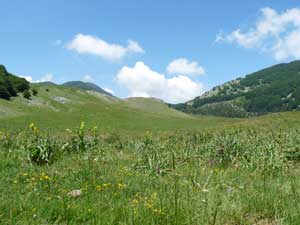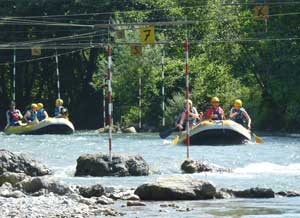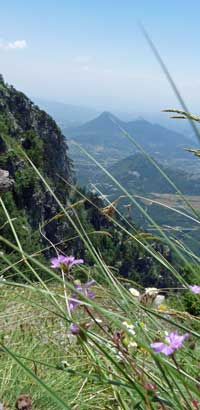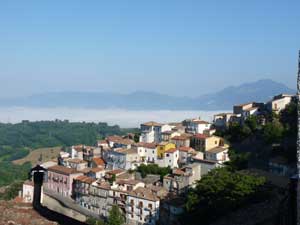 The Pollino National Park (Parco del Pollino) is a large, protected mountainous area in the far south of Italy, spreading over the border from Basilicata into the neighbouring region, Calabria. It is the largest national park in Italy, covering nearly two thousand square kilometres. Much of the park is wooded slopes, with bare grassy summits rising above. The highest points are Serra Dolcedorme (2,267m) and Monte Pollino (2,248m).
The Pollino National Park (Parco del Pollino) is a large, protected mountainous area in the far south of Italy, spreading over the border from Basilicata into the neighbouring region, Calabria. It is the largest national park in Italy, covering nearly two thousand square kilometres. Much of the park is wooded slopes, with bare grassy summits rising above. The highest points are Serra Dolcedorme (2,267m) and Monte Pollino (2,248m).
There are several villages and small towns within the borders of the park. This part of Italy is fairly sparsely populated, though, and with the extra protection given by its national park status, the Pollino offers a chance to see a significant expanse of landscape that is little damaged by man. Where people have made a mark, development is still largely pre-twenty-first century, with picturesque traditional villages and small-scale farming. Traditional ways of life are still important, from annual rural festivals to small traditional haystacks piled around poles in villages.
Among the villages is the pleasant hillside settlement Viggianello, which along with nearby Rotonda would make a good base for exploring the park. There is also a cluster of Albanian villages, dating back to migrations in the fifteenth and sixteenth centuries.
From its steep wooded river-valleys to high bare hilltops, the Pollino harbours important wildlife, including golden eagles and other birds of prey, and even a few, rarely glimpsed, shy wolves. The emblem of the park is the Bosnian pine (pino loricato) which grows here and in the Balkans.
Walking in the Pollino National Park

There are waymarked footpaths and good hiking opportunities in the Pollino. The National Park headquarters are in the town of Rotonda; park and tourist information offices throughout the region should be able to provide maps and detailed information on hiking in the area. There’s quite a range of terrain, from historic routes connecting villages to excursions up to the high summits.
For many Italians, the park is a popular leisure resource. Visitors can drive up to woodland parking spots or high passes, walk among peaceful natural surrounding and return to a countryside trattoria for a filling lunch. Picnicking is popular too, and you’ll see Italian families sitting down for civilised feasts, spread out on picnic tables. We enjoyed a very pleasant, easy short walk from the Rifugio De Gasperi, where there was parking and a few makeshift stalls selling local artisan products. The attractive stroll took us down an empty road, across wild grassland full of flowers and through a short stretch of woodland to the Belvedere di Malvento, a panorama over the southern Italian landscape. A short drive back down the road is La Baita, a bar-restaurant at Piano Visitone, where park visitors fill up on pasta, or enjoy convivial picnics in the grassy clearing.
To find good hiking opportunities, I’d suggest consulting your hotel or the park headquarters for detailed advice and itineraries. You may find it convenient to join an organised hike or arrange to hire a guide.

Other activities
Other types of activity are possible as well as walking in the Pollino, if you fancy an action-packed break. Despite being so far south, the massif is high enough to get a snow covering in winter, allowing for organised cross-country skiing excursions. In warmer months, horse-riding and mountain-biking are alternative ways to explore the uplands. For some high-octane excitement, you could try white-water rafting within the national park, on the river Lao. At a rafting and canoeing centre just over the Calabrian border, near Laino Borgo (see links panel), you can choose from various types of water activity, including rafting down gorges, or even embarking on a long expedition down the river to the sea.
Practicalities

The Pollino National Park can fit into itineraries touring either Basilicata or Calabria. The greatest destination in Basilicata is the UNESCO-listed cave-town Matera, which is 2-3 hours’ drive away. However, the park is actually much nearer to another very attractive Basilicata holiday base: Maratea, on Italy’s western Tyrrhenian coastline. If you are spending a few days in the Pollino, it would combine well with a short stay in either Matera or Maratea, or perhaps a Calabrian coastal town such as Scalea, which is very close to the borders of the park. A trip to the national park would be a good addition to this Tyrrhenian coast itinerary: South to Calabria.
The most convenient airports for the area are Bari, Naples and Lamezia Terme; unfortunately none of these are very close by. There is a major railway line down the Tyrrhenian coast, with stations including Maratea, Sapri, and Scalea, which make possible access points if you are depending on trains and buses. Disappointingly, public transport is not well-developed within the national park and you will find logistics very hard if you are visiting without a car; your best bet may be to book organised walks or arrange lifts and transfers through a walking guide or your hotel. If you are relying on buses, useful firms (see links panel) include SAM Autolinee, with buses linking the park settlements including Castelluccio, San Severino Lucano, Viggianello and Rotonda, connecting with the long-distance services of SLA, who operate buses from Naples to Rotonda.
Accommodation
I stayed in the simple Locanda di San Francesco in the pleasant village of Viggianello. The hotel is used to entertaining hikers and walking groups and can organise guided tours. The village has a few accommodation options and makes a good base for visiting the Pollino National Park includes:
> Hotels and B&Bs in Viggianello and around.
I visited the Pollino National Park as a guest of Basilicata APT, the regional tourist board. Their official UK website can be visited at Discover Basilicata UK.
Basilicata region
Locanda di San Martino, Matera
Locanda delle Donne Monache, Maratea
On this site
Puglia and Matera: a travel itinerary
Useful external links
Parco Nazionale del Pollino official website, in Italian
Parco Nazionale del Pollino (English)
SAM Autolinee Pollino & Potenza
SLA Autolinee Naples – Rotonda
Viaggiare nel Pollino – useful website by English-speaking walking guide
Lao Pollino canoe & rafting centre
Exploring Basilicata: Ramblers Holidays
La Baita Bar-ristoro (Facebook)
Locanda di San Francesco, Viggianello
ViaMichelin (driving routes)
Discover Basilicata UK official tourism website